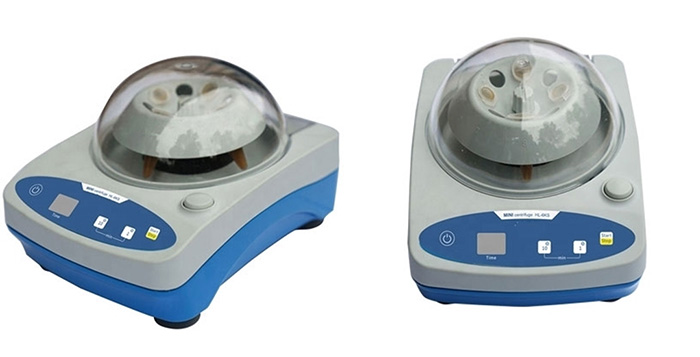Application of Laboratory Centrifuge in Various Fields
Laboratory centrifuge machines are commonly used instruments that use the centrifugal force generated by rotating rotors to separate substances of different densities and particle sizes in suspension or emulsion. They are widely used in various fields such as medical, cosmetic, dental, chemical industry, food, pharmaceutical, environmental protection, mining, and teaching. Different fields require different centrifuge parameters (such as speed, single tube capacity, time, temperature, etc.) for processing samples, and it is necessary to choose the appropriate instrument according to specific experimental needs.

Medical field
The samples commonly centrifuged in the medical field are blood samples, urine samples, stool samples, etc.
- Blood sample centrifugation: usually requires a speed of 3000 revolutions and a time of about 10 minutes.
- Urine sample centrifugation: usually requires a speed of 1800 rpm, and the time is about 5 minutes.
- Fecal sample centrifugation: usually requires a speed of 1000 revolutions and a time of about 10 minutes.
Cosmetology and stomatological hospitals field
In the fields of cosmetology and stomatological hospitals, separation of PRP (Platelet-rich plasma), PRE (preemptive analgesia), CGF (Concentrate Growth Factors), and other materials is often required.
- PRP: Usually needs to be centrifuged at 300-3500rpm for around 5 minutes, with two or more centrifugations.
- PRF: Usually needs to be centrifuged at 2000-3000rpm for around 7 minutes, with a single centrifugation.
- CGF: Usually requires a 3 or 4 steps of variable speed centrifugation process.
Biological laboratory field
Laboratory centrifuges are widely used in biological research, such as DNA/RNA extraction, cell separation, protein purification, virus isolation, etc. Centrifuges can separate biological molecules such as cells and proteins and can extract target substances quickly and efficiently. At the same time, the centrifuge can also be used to centrifuge cells, separate cells in the blood, and separate the nucleus and cytoplasm of cells.
- For the precipitation and collection of cells, cell nuclei, and cell membranes: usually use a horizontal rotor low-speed centrifuge.
- For the preparation and collection of microorganisms, cell debris, large organelles, etc.: usually use a high-speed centrifuge.
- For separation, purification, identification, and analysis of mitochondria, microsomes, chromosomes, lysosomes, plasmids, macromolecular nucleic acids, high molecular proteins, etc.: usually used in ultracentrifuges.
Chemical field
Laboratory centrifuges are also widely used in the field of chemistry. For example, it is used for the separation of solid-liquid mixtures, the separation of products after synthetic chemical reactions, the separation of mixtures, etc. Centrifuge machine can separate solid and liquid mixtures, which can improve experimental efficiency and separation purity, thereby promoting the progress of chemical research.
Food field
Laboratory centrifuges are also widely used in the field of food science, such as for the determination of fat content, moisture content, etc. in food samples. Centrifuges can separate solid and liquid mixtures, which can improve experimental efficiency and separation purity, thereby promoting the progress of food science research.
- Centrifugal treatment of pesticide residue detection samples: usually the rotation speed is required to be around 4000 rpm, and the centrifugation time is about 5 minutes.
- Preparation of starch from starch liquid; preparation of cream or skim milk from milk; separation of crystals from mother liquor to obtain pure crystal food; experiments such as improving the purity of products: usually use low-speed centrifuges or low-speed refrigerated centrifuges.
- Separation of spores in milk: usually using a high-speed centrifuge.
Environmental science field
In the field of environmental science Laboratory centrifuges are also widely used in environmental science, for example for treating water samples, soil samples, etc. Centrifuges are capable of separating suspended particles, contaminants, etc. from water samples, enabling rapid extraction and separation of target substances, as well as separating and concentrating samples such as microorganisms.
Laboratory centrifuges have a wide range of applications in various fields, not only to achieve the separation and processing of samples but also to improve the accuracy and efficiency of analysis. Therefore, centrifuges are one of the necessary equipment for laboratories and an important tool for various industries. Of course, in order to ensure the normal operation of the centrifuge, it is necessary to pay attention to the maintenance and care of the centrifuge to extend its service life.
ATO online store offers a mini digital laboratory centrifuge at 6000 rpm with an LCD display and a relative centrifugal force of 2100xg. It has an elegant appearance, is small and portable, and has a wide range of applications to meet the needs of different experiments. Welcome to purchase.

